Summary During the month of December, 2011, the veterinary unit managed to attend to an adult female cheetah with an extensive injury on the interdigital space of the right front leg
Summary
During the month of December, 2011, the veterinary unit managed to attend to an adult female cheetah with an extensive injury on the interdigital space of the right front leg. Ten elephants were also fitted with GPS/GSM collars in the entire Mara ecosystem. The collars were meant to enhance regular monitoring of elephant movements across Mara and to help secure elephant movement corridors. This will also help to reduce incidences of human-elephant conflicts in Mara.
Treatment of an injured cheetah (Acinonyx jubatus) in Olare Orok Conservancy
This was an adult female cheetah which had been monitored for many years in Masai Mara and has given birth to several cubs; it had two young cubs at the time it was being sighted with an injury on the right front foot. It was reported ill by community wildlife scouts in Olare Orok Wildlife Conservancy, it was already very weak and limping caused by painful injury on the right front leg. It was unable to hunt on its own and it had to be fed by the game scouts. Therefore it required an urgent veterinary attention before the condition got worse.
Chemical restrain
The cheetah was darted from a close distance using 150mgs of ketamine combined with 1.5mgs of medetomidine hydrochloride on the right thigh; it took about 5 minutes for the drug to take effect. It was then transferred to a cool shade under a tree from where it was examined and treated. Both the eyes were covered with opticlox® eye ointment to avoid desiccation and conjunctivitis while it was recumbent. The dart was removed and dart wound treated using Opticlox® eye ointment. The vital physiological parameters were monitored and recorded as follows; respiration rate 23 cycles/minute, deep and regular, pulse rate of 110 beats/minute, strong and regular, body temperature was 38 degrees Celsius, all the mucosal membranes had pink normal colour and capillary refill time (CRT) was 2 seconds. It was in a very stable anaesthesia and all examination and treatment procedures went on without difficulties.
Clinical examination
The cheetah had a very deep cut wound on the interdigital space which was very painful and itchy. The wound seemed to have stayed for at least 1 week and was not healing as is expected. It had some external parasites such as ticks and lion flies on the skin. The cause of the injury could not be ascertained, but required urgent treatment so that the animal could resume hunting and take care of the young cubs.
Treatment
The wound was properly debrided and cleaned using clean water and then 10% hydrogen peroxide; it was also topically treated using a tincture of iodine applied on it and then sprayed by oxytetracycline spray. The wound was already infected and could not be sutured. The animal was further treated using antibiotics (Amoxycillin) Betamox® and dexamethasone administered intramuscularly to counter inflammatory reactions and to reduce pain.

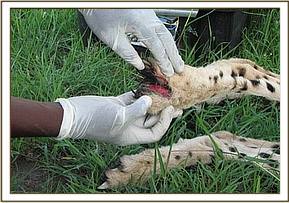
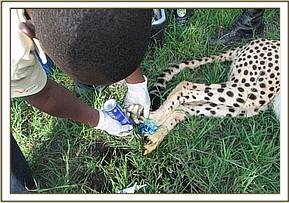


Samples collection
Blood samples were collected routinely in EDTA coated tubes and plain tubes coated with clot retractor and kept in a cool box, tissue and hair samples kept in ethanol solution and ectoparasites such as ticks and lion flies collected and stored in 70% ethanol. These samples have been processed and stored in KWS lab for further analysis and for health monitoring purposes.
Prognosis
The cheetah had good chances of healing after treatment but it required provision of food for at least a week before regaining enough strength to hunt on its own. It was to be monitored closely by the rangers at the Olare Orok Conservancy who would report on its progress just in case it required a repeat treatment. After about 1 hour the cheetah managed to rise up on its own without any antidote administered and successfully rejoined its cubs.
Collaring of elephants in Masai Mara ecosystem
There is need for intensive daily monitoring of elephant populations in the entire Masai Mara ecosystem in order to map out the elephant movement corridors and to reduce incidences of human-elephant conflict (HEC). Recent increase in human population and settlements, expansion of agricultural land and loss of wildlife habitat are some of the reasons for increase of human-elephant conflict cases in the area. Human injuries and deaths are some of the most prevalent effects of human-elephant interaction in Masai Mara. Ten adult elephants spread in different parts of Mara were captured and fitted with GPS/GSM collars. The elephant herds were sighted and identified either from a vehicle or from an aircraft, then the right candidate was darted using Dan-inject dart gun using etorphine combined with hyaluronidase. The collars were adjusted to size and fitted to each elephant one at a time, the collars were designed to use satellite network and send GPS locations of elephants at an interval of 4 hours everyday for the next 5 years.
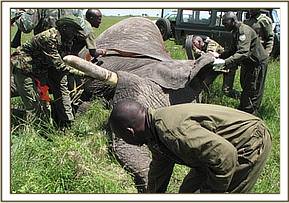
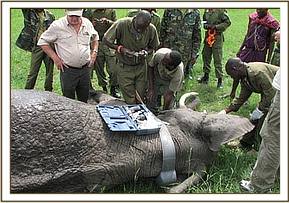
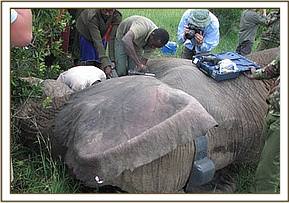

Revival of anaesthesia
After fitting the collar, each elephant was revived from anaesthesia using 48mgs of diprenorphine hydrochloride administered through the superficial ear-vein, the collaring exercise was quite successful and both the collared elephants joined the rest of elephant herds without any complications.
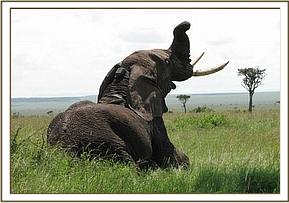
Report by: Dr. Domnic Mijele